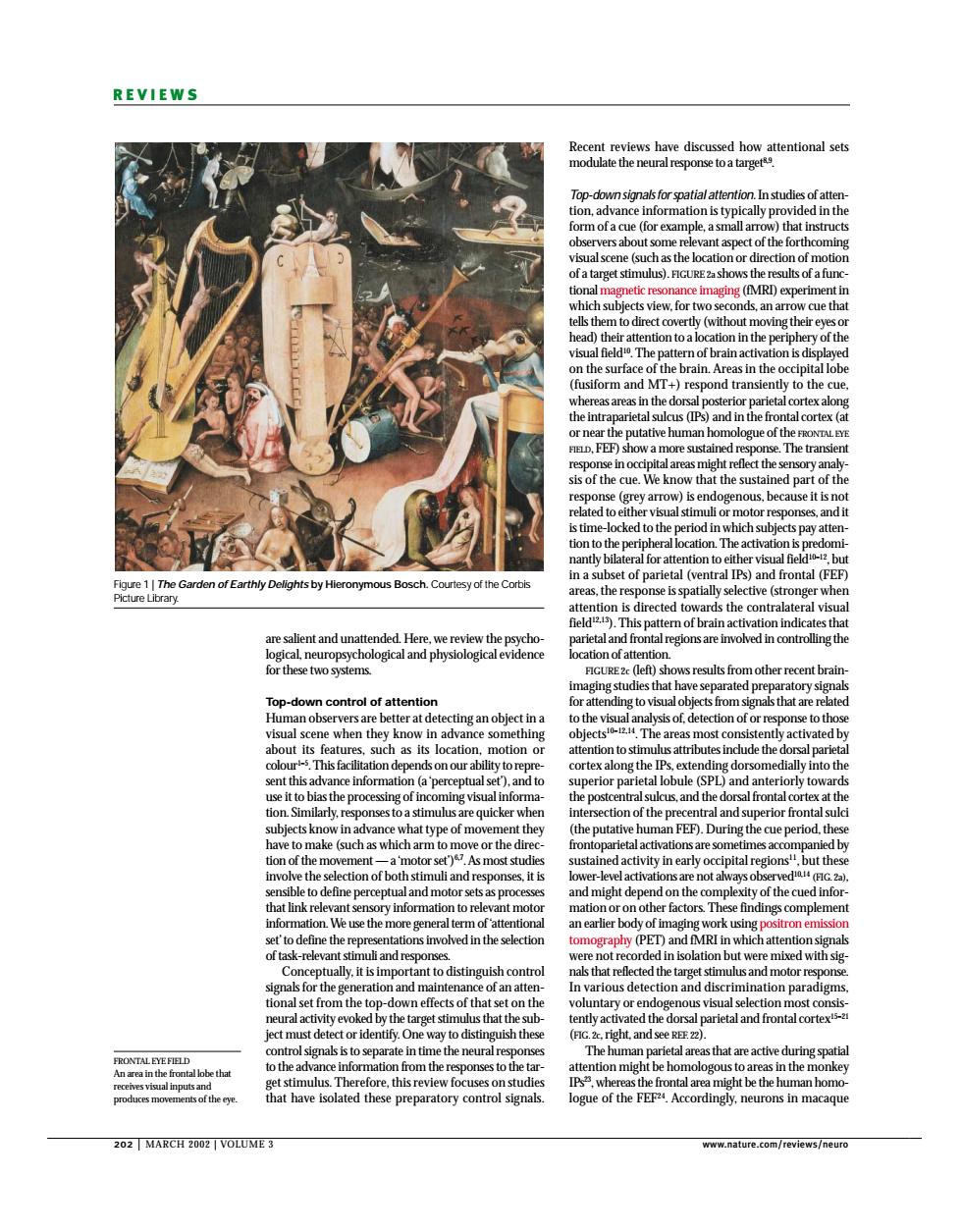正在加载图片...

REVIEWS no th Top-downcotenion cene when they kno This facil on dep on our a the ubiects know in advar eme ton of the (uc orthe m s but th nd motor sets on the yof the cue on of 'at d in the selectio ived with s ary or e b the guish the ight,and see 1a hom ologous nke hat haw ted these preparatory control signal logue of the FEFAccordingly,neurons in macaque 202 MARCH2002 VOLUM正 nature com/reviews/neuto FRONTAL EYE FIELD An area in the frontal lobe that receives visual inputs and produces movements of the eye. 202 | MARCH 2002 | VOLUME 3 www.nature.com/reviews/neuro REVIEWS Recent reviews have discussed how attentional sets modulate the neural response to a target8,9. Top-down signals for spatial attention.In studies of attention, advance information is typically provided in the form of a cue (for example, a small arrow) that instructs observers about some relevant aspect of the forthcoming visual scene (such as the location or direction of motion of a target stimulus). FIGURE 2a shows the results of a functional magnetic resonance imaging (fMRI) experiment in which subjects view, for two seconds, an arrow cue that tells them to direct covertly (without moving their eyes or head) their attention to a location in the periphery of the visual field10. The pattern of brain activation is displayed on the surface of the brain. Areas in the occipital lobe (fusiform and MT+) respond transiently to the cue, whereas areas in the dorsal posterior parietal cortex along the intraparietal sulcus (IPs) and in the frontal cortex (at or near the putative human homologue of the FRONTAL EYE FIELD, FEF) show a more sustained response. The transient response in occipital areas might reflect the sensory analysis of the cue. We know that the sustained part of the response (grey arrow) is endogenous, because it is not related to either visual stimuli or motor responses, and it is time-locked to the period in which subjects pay attention to the peripheral location. The activation is predominantly bilateral for attention to either visual field10–12, but in a subset of parietal (ventral IPs) and frontal (FEF) areas, the response is spatially selective (stronger when attention is directed towards the contralateral visual field12,13). This pattern of brain activation indicates that parietal and frontal regions are involved in controlling the location of attention. FIGURE 2c (left) shows results from other recent brainimaging studies that have separated preparatory signals for attending to visual objects from signals that are related to the visual analysis of, detection of or response to those objects10–12,14. The areas most consistently activated by attention to stimulus attributes include the dorsal parietal cortex along the IPs, extending dorsomedially into the superior parietal lobule (SPL) and anteriorly towards the postcentral sulcus, and the dorsal frontal cortex at the intersection of the precentral and superior frontal sulci (the putative human FEF). During the cue period, these frontoparietal activations are sometimes accompanied by sustained activity in early occipital regions11, but these lower-level activations are not always observed10,14 (FIG. 2a), and might depend on the complexity of the cued information or on other factors. These findings complement an earlier body of imaging work using positron emission tomography (PET) and fMRI in which attention signals were not recorded in isolation but were mixed with signals that reflected the target stimulus and motor response. In various detection and discrimination paradigms, voluntary or endogenous visual selection most consistently activated the dorsal parietal and frontal cortex15–21 (FIG. 2c, right, and see REF. 22). The human parietal areas that are active during spatial attention might be homologous to areas in the monkey IPs23, whereas the frontal area might be the human homologue of the FEF24. Accordingly, neurons in macaque are salient and unattended. Here, we review the psychological, neuropsychological and physiological evidence for these two systems. Top-down control of attention Human observers are better at detecting an object in a visual scene when they know in advance something about its features, such as its location, motion or colour1–5. This facilitation depends on our ability to represent this advance information (a ‘perceptual set’), and to use it to bias the processing of incoming visual information. Similarly, responses to a stimulus are quicker when subjects know in advance what type of movement they have to make (such as which arm to move or the direction of the movement — a ‘motor set’)6,7.As most studies involve the selection of both stimuli and responses, it is sensible to define perceptual and motor sets as processes that link relevant sensory information to relevant motor information.We use the more general term of ‘attentional set’to define the representations involved in the selection of task-relevant stimuli and responses. Conceptually, it is important to distinguish control signals for the generation and maintenance of an attentional set from the top-down effects of that set on the neural activity evoked by the target stimulus that the subject must detect or identify. One way to distinguish these control signals is to separate in time the neural responses to the advance information from the responses to the target stimulus. Therefore, this review focuses on studies that have isolated these preparatory control signals. Figure 1 | The Garden of Earthly Delights by Hieronymous Bosch. Courtesy of the Corbis Picture Library